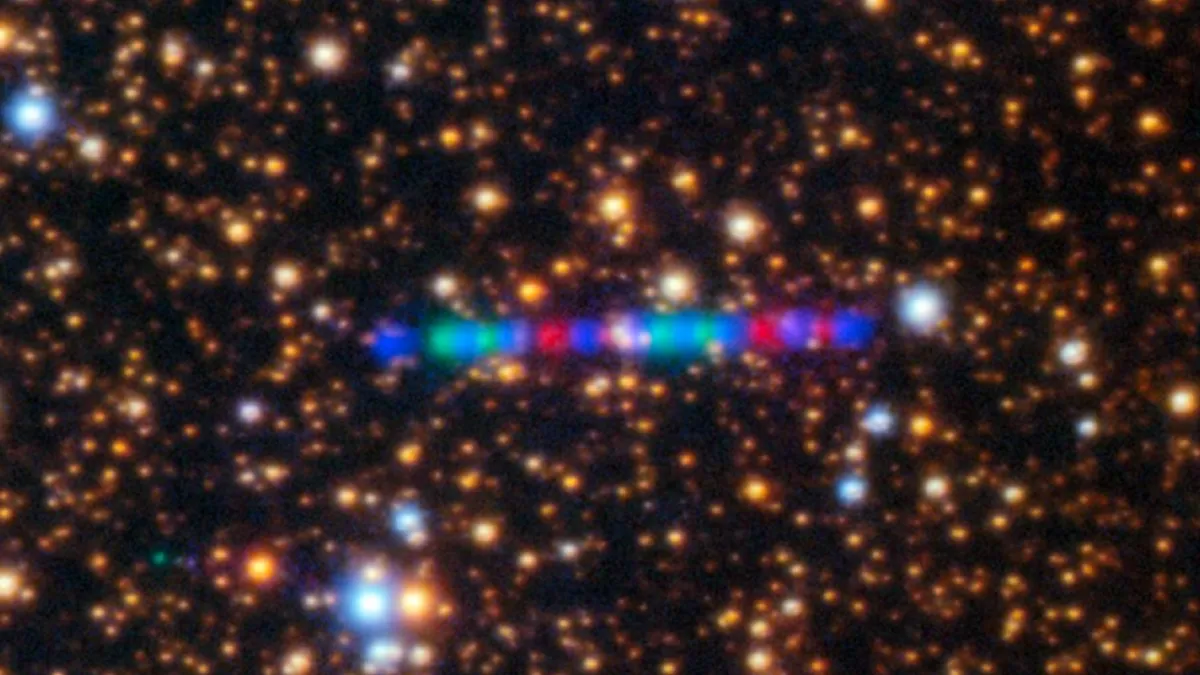
The newly discovered interstellar visitor, 3I/ATLAS, is captivating the attention of astronomers and space enthusiasts alike. This fascinating cosmic entity appears as a shimmering, rainbow-colored string of cosmic pearls in a stunning new timelapse image taken by a telescope in Hawaii. Discovered on July 1, 2023, NASA confirmed within 24 hours that this object is indeed an interstellar marvel—an ejected fragment from an alien star system racing through our cosmic neighborhood.
3I/ATLAS is only the third object of its kind ever identified, and it is believed to be a large comet, measuring up to 15 miles (24 kilometers) in diameter. Initial observations indicate that this interstellar object could be up to 3 billion years older than our solar system, potentially making it the oldest comet ever observed. This intriguing comet is hurtling towards the sun at a staggering speed of over 130,000 mph (210,000 km/h). It will reach its closest point to our sun, known as perihelion, in late October, before embarking on a long journey back out of the solar system. This limited window presents scientists with a unique opportunity to study 3I/ATLAS before it disappears from view forever.
Astronomers at the Gemini North telescope, located on the summit of Hawaii's Mauna Kea volcano, have been meticulously tracking 3I/ATLAS since its discovery. On July 15, they unveiled several breathtaking images, including a detailed close-up shot of the comet's coma—the cloud of ice, gas, and dust enveloping the comet's icy core. The highlight of the release was a vibrant timelapse photograph showcasing the interloper's movement through space.
This mesmerizing timelapse image is a composite of at least 16 different photographs taken using three distinct filters, creating a stunning visual effect as the comet appears to shift between blue, red, and green hues while traversing the sky. In reality, the comet emits a white light, as evidenced in the coma photograph. These images have provided astronomers with crucial early characterization data on this interstellar wanderer. Martin Still, the National Science Foundation program director for the International Gemini Observatory, expressed excitement about the wealth of new data and insights expected as the comet warms under sunlight, paving the way for further exploration of its journey through space.
To date, only two other interstellar objects have been confirmed: 1I/'Oumuamua, an atypical asteroid discovered in 2017, and 2I/Borisov, a pristine comet spotted in 2019. Researchers believe that many more alien interlopers may have traversed the solar system unnoticed. However, 3I/ATLAS stands out due to its significantly larger size and faster velocity compared to its predecessors. It also originates from an entirely different region of the Milky Way than 'Oumuamua or Comet Borisov, making it a prime candidate for future studies.
Astronomers are eager to uncover more about the origins of this comet as it approaches the sun, which will gradually melt away its outer icy layers. This process is expected to produce a massive cometary tail, providing an excellent opportunity for detailed studies using advanced space assets, such as the James Webb Space Telescope.
3I/ATLAS will make its closest approach to Earth in mid-December after temporarily disappearing behind the sun during October and November. Its minimum distance from our planet will be approximately 1.6 times the distance between Earth and the sun, ensuring that it poses no threat to us, according to NASA. As we await this spectacular cosmic event, the scientific community is buzzing with anticipation of the discoveries yet to come from this remarkable interstellar visitor.